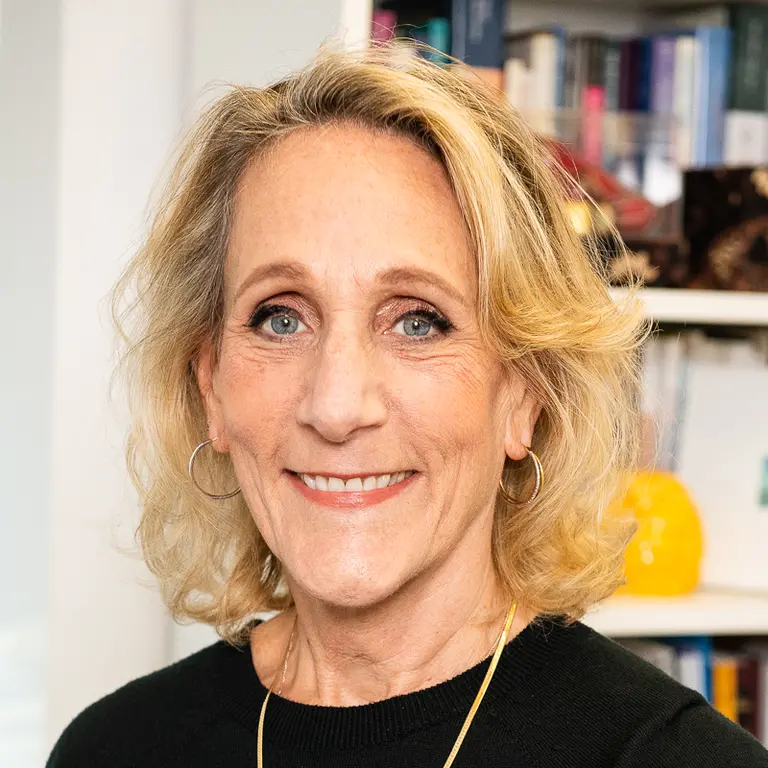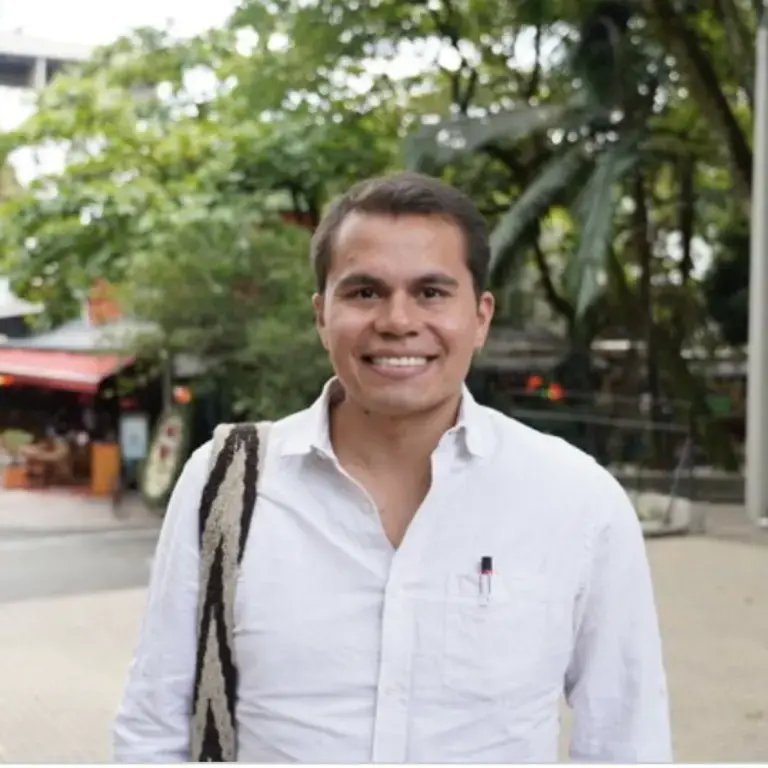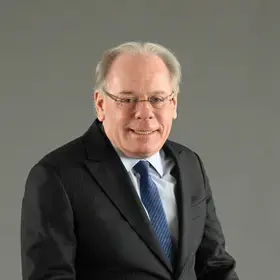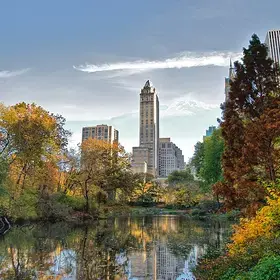By Dr. Beth Fisher-Yoshida, Dr. Peter Dixon, and Joan C. Lopez
The construction of peace presupposes the presence of a violent conflict. In the case of Medellín, Colombia, this is not so obvious. As the most violent city in the Americas in the early 1990s, and home to waves of urban militias, narcotrafficking, guerrilla warfare, and paramilitary violence in the 2000s, Medellín is today one of Latin America’s most highly desirable tourist spots and a well-known destination for digital nomads. Some say the city is at peace: an urban miracle—el milagro de Medellín. Conversations about peacebuilding are unnecessary, they say—even absurd.
And yet Medellín’s “negative peace” hides troubling structures of violence under the surface. The city is controlled by criminal armed groups that tightly control security through a system of vacunas: extortions that guarantee security through violent means. Conversations about peace and peacebuilding are as relevant today as they were in the 1990s. But peace is not an easy topic of conversation in Colombia. Especially since the 2016 Peace Accords between the government and the FARC nonstate armed group, it has become a charged and politicized topic that many people would just as soon ignore.
How then can Colombians talk productively about peace? We think the university has an important role to play. In this article, we discuss the role of academia as a key player in conversations about peace while asking the question: Why and how should we talk about peacebuilding in a time of “peace”?
Debating “Urban Peace” in a “Peaceful” City
Beginning in 2023, faculty from the Negotiation and Conflict Resolution (NECR) program at Columbia University met with Colombian social activists and academics to discuss the current state of Colombia’s peace under the presidency of Gustavo Petro, Colombia’s first left-wing government. Under Petro, the peace process is called Paz Total, or total peace, and it’s being negotiated between the national government and a series of armed actors that include the last existing guerrilla group on the continent, the Army for National Liberation (Ejercito de Liberación Nacional), the Clan del Golfo—an armed Frankenstein’s monster that resulted from the fusion of paramilitary, narcotrafficking, and criminal groups—and youth gangs in urban centers.
In our conversations, Colombian social activists and academics expressed strong concerns about the advances of Paz Total in Medellín, which the city’s mayor, Federico Gutierrez, has opposed in favor of “iron fist” policies rooted in urban security. It was impossible to speak about peace in Medellín, they told us, exacerbated by clashes between the national left-wing and local right-wing governments. There was a strong sense of urgency in the conversation. “This is dangerous,” they said. “Medellín is a time bomb.”
As a major city controlled by some of the country’s most powerful criminal groups, Medellín plays a central role in the success of the Paz Total negotiations. With that in mind, this group of NECR faculty, long-term partner organization Getting Up, social activists, and academics organized the International Conference on Urban Peace in Medellín, which took place September 19–22, 2024.
The conference was curated with principles and methodologies of conflict resolution and peace studies, to recenter the conversation about peace among academics, grassroots peacebuilders, social activists, and policymakers from local, state, and national levels in a city where peace is illusory or fragile at best. Together with our partners, we organized the conference into four days, each focusing on a different corner of the peacebuilding field, with several opportunities for dialogue:
Day one was centered on contributions from the academy. Information was shared about understanding the current dynamics of the conflict and peacebuilding through the lenses of multiple academic disciplines, from Colombian universities, the University of Salamanca, and Columbia. This was meant to inform the participants and create a shared understanding of the complexity of the situation.
Day two brought on-site visits to several different grassroots initiatives around Medellín. Participants had the chance to experience the activities of these arts-based organizations that were mostly focused on the peaceful development of youth.
- Day three brought in policymakers from different levels of government, including local, state and national representatives. State- and national-level framing of the situation and their initiatives were shared. There was a notable absence of local government representation.
- Day four was the culminating festival, with soccer games, a rapping competition, and a Latin jazz performance. It was a very exciting and wonderful way to conclude this ambitious first attempt at gathering different sections of civil society to be present and engage in this important conversation.
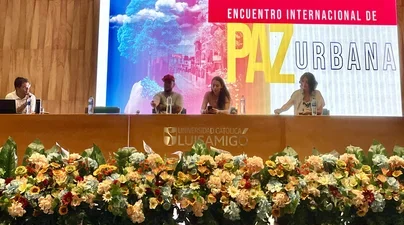
Panel discussion during the International Conference on Urban Peace in Medellín, Colombia.
Using Academic Spaces to Reimagine Peace
John Paul Lederach distinguishes between prescriptive and elicitive models of peacebuilding. Where prescriptive models seek to transfer approaches across contexts, elicitive models aim to harness local resources, knowledge, methods, and cultures to create solutions through communication and dialogue. Both are important, but they rely on different institutional mechanisms to realize change. In place of large agencies with the resources necessary to prescribe solutions across place and time, elicitive approaches depend on spaces of interaction and engagement where diverse, sometimes antagonistic stakeholders can come together safely and constructively.
This is where academia can play a key role.
Universities occupy a unique place between government, industry, and civil society. At their best, they serve as credible spaces that can welcome conflicting interests and perspectives for the purposes of learning and generating knowledge. Universities also typically benefit from robust and expansive social networks that extend across fields and disciplines. When academics can draw on these networks to convene diverse stakeholders around local challenges, the potential to elicit creative solutions is strong.
The NECR program at the School of Professional Studies and the Advanced Consortium for Cooperation, Conflict and Complexity (AC4) at the Climate School both benefit from vibrant networks across the peacebuilding field, especially in Colombia. Since 2014, Dr. Beth Fisher-Yoshida and Joan Camilo Lopez have been working with academics, civil society, and policymakers in Medellín on a broad set of issues related to urban peace. One of their objectives was to work in partnership with these different sections of society to enhance the work they were doing by sharing best practices from Columbia. At the same time, they wanted to learn from those in Medellín doing peacebuilding work in real time. This partnership provided ample opportunities for mutual growth through participatory-action research initiatives.
Each summer, Fisher-Yoshida and Lopez bring a cohort of Columbia students to learn about this work and local peace efforts firsthand. They work with a university from Bogotá, Universidad de Los Andes, and students from there join the Columbia students in the field. Dr. Dixon has been working in Colombia with his team at Everyday Peace Indicators to measure how local peace is defined at local levels, and how these measure up to national programs and policies.
Peacebuilding and Conflict Transformation
Peacebuilding is an important part of conflict transformation. In looking at the context of Colombia, transitioning out of 60-plus years of civil war, we can identify conditions that are ripe for peace and others that need to change for peace to be realized.
Youth leaders, educators, social service organizations, and some political figures are enthusiastic about this. There is still work to be done in aligning the national, state, and local-level political leadership and their initiatives with civil society, whose voices have not been consistently heard.
Drawing on Johann Galtung’s concepts of the different forms of violence and their relationship to peace, we can see in Medellín the significant gaps Colombia still faces in establishing sustainable peace. While the 2016 Peace Accords helped reduce the most evident forms of violence, what Galtung called direct or episodic, Colombian civil society is still experiencing deeply ingrained forms of structural and cultural violence, as per his model.
Colombia needs investments in social and economic development and stronger social institutions to establish truly sustainable positive peace.
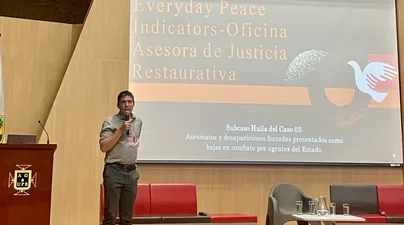
Dr. Peter Dixon presenting at the International Conference on Urban Peace in Medellín, Colombia.
Creating Knowledge
Just as different forms of violence can hinder peace, so are there multiple forms of knowledge necessary for peacebuilding. There are various ways of knowing and demonstrating that knowledge. More formal means of education are through the academy. However, there are myriad ways of learning and demonstrating knowledge through creative outlets such as writing, visual arts, music, and dance. Some of these peacebuilding initiatives through the arts were showcased at the conference. It emphasized that local knowledge is critical to the holistic development of communities. It raised the profile of several grassroots leaders and their initiatives.
Visiting the local sites in Medellín where their work takes place strengthened the connections among the participants, although attendance on this day was less than others. These community-led initiatives need to be more fully supported and integrated with municipal activities.
What’s Next?
The Paz Total process requires ongoing conversations between civil society and government across Colombia. For that to happen, especially because it is a new initiative and not yet a custom, universities and civil society organizations need to continue creating spaces to gather these different stakeholders at the local, state, and national levels to forge more integrated ways of implementing the ambitious vision of Paz Total.
All levels of civil society must be represented for the appropriate trickle-down effect of bringing these efforts to every level of the community. Therefore, there needs to be explicit support for grassroots efforts at peacebuilding, as they are more localized and accessible to community members.
Colombia has a peace process that takes place about every 20 years. While peace negotiations have addressed overt forms of violence in significant ways, they are insufficient in their prevailing form. Peace processes have been negotiated predominantly by warriors, from army generals to guerrilla commanders to paramilitary leaders. Peace has been negotiated by those who make war. Community leaders—who make life possible in the middle of the war—also need a voice in peace processes. To truly elicit creative and sustainable solutions, peace negotiations must be inclusive. Peace itself must be taught and distributed by peacebuilders and not by warriors alone.
About the Program
Columbia University’s Master of Science in Negotiation and Conflict Resolution prepares students to analyze the root causes and dynamics of conflict and to transform disputes through reasoned and resourceful interventions. The program focuses on developing self-awareness, tenacity, and interpersonal competency; building common ground; opening lines of communication; ensuring representation and recognition, and building sustainable possibilities for resolution.
The fall 2025 application priority deadline for the M.S. in Negotiation and Conflict Resolution program is January 15. The final deadline is May 1. Learn more here.
